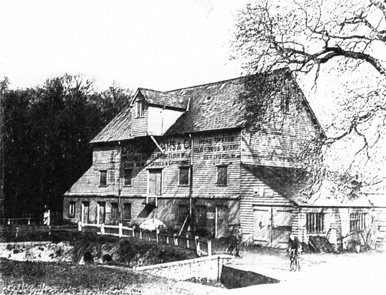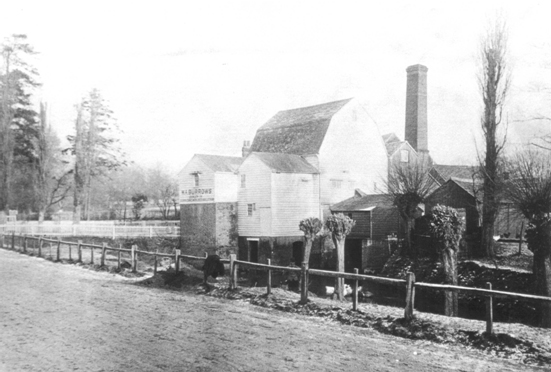The Brown family and flour milling
Many descendants of the Brown family were connected with flour milling. From Frederick Shadrach Daniel Brown, who operated a steam flour mill at 16 Sun Street, Waltham Abbey, Essex, in 1851, to his grandsons Herbert and Harold Brown in the twentieth century.
Amwell End Mill, Ware
Frederick’s first son, Alfred Augustus Brown, established himself at Amwell End in Ware, Hertfordshire. In 1859, he set up a steam flour mill on the river Lea that was employing 4 men and 2 boys within two years. He continued as miller until about 1881/2, although he might have still been running the mills until the 1890s when F. W. French & Co. purchased the site and opened the Ware Flour Mills in 1897. This continued as a large and flourishing business until it finally closed in 1983. The buildings were demolished and new residential apartments were put on sale in 1988. Few people in Ware know there had been an earlier mill on the site, which is not surprising considering the impact French’s had on the town.
Wades Mill, Thundridge
For several years in the 1880s, Alfred Augustus Brown worked the steam mills at Amwell End as well as Wades Mill at Thundridge, a small village a few miles to the north of Ware, where the river Bourne joins the river Rib. He also leased Thundridge Hill Farm. Wades Mill, situated on Ermine Street, the Roman road from London to the north, had been in existence even before Domesday in 1086. Alfred, together with his sons, Alfred A. F. Brown and Frederick Charles Brown, continued as millers at Wades Mill until he died at The Limes in Therfield, Hertfordshire, in 1906. Frederick Charles moved to London and became a flour factor. Although the mill may have continued in operation for some years, it was later largely rebuilt as apartments, although some of its original features can still be seen. Now that the A10 bypasses Thundridge and Wadesmill, the villages have returned to the peace and quiet that would have been familiar to Alfred and his family. His daughter Sarah Elizabeth Brown married a local farmer, John Terry, and her daughter Dorothy continued to live at Labdens House in Colliers End until her death in 1984.
Kingsbury Mill, St. Albans
The second son was Frederick Brown. He was the miller at Kingsbury Mill in St. Albans until at least 1880. There had been a mill at Kingsbury since Saxon times, and it was grinding the grain grown on the Gorhambury Estate until the late 1920s. It was leased to Whitworth Brothers but finally ceased milling flour in 1936. In 1982 the Waffle House restaurant opened in what used to be the “Millers Parlour”, and the old mill was restored as a working museum but is now closed. After Frederick’s death in 1902 his eldest son Harold continued his flour milling business, at one time operating three mills in Hertfordshire.
Waddon Mill, Croydon; Tower Bridge Flour Mills, Bermondsey; Royal Flour Mills, Albert Embankment, Lambeth
The third son was Charles Brown, and he was by far the most successful miller. After he married and moved to Croydon, Surrey, he took over Waddon Mill on the river Wandle. The previous mill had been built in 1789 to the designs of the engineer, Charles Smeaton, but it had burned down. The mill that Charles took over was housed in a large brick building, driven partly by water from the Wandle and partly by steam. A railway spur was constructed to connect it to the West Croydon to Mitcham Junction line (now part of the Tramlink), which meant he could distribute his flour throughout the country. He soon opened the Tower Bridge Flour Mills in Bermondsey and another mill on the Albert Embankment. Charles Brown & Co., or Charlie Brown’s as it was known, became a very well known commercial supplier of flour. According to an advertisement in 1911:
Messrs. Charles Brown and Co. not only do not, but never have, bleached any of their flours in any way whatever or added any admixture – chemical or otherwise – thereto.
Charles died in 1915 and the milling continued as a family business run by his sons, Edmund Dunn and Herbert Brown, but it was finally sold to Spillers in 1953. The Royal Flour Mills on Albert Embankment were demolished about 1955 to make way for new office blocks next to Tintagel House. Waddon Mill was demolished and an industrial estate took its place.
Powhays Mill, Exeter St. Edmund
The fourth son, Edmund Brown, started milling in 1861 with £1000 from his father. Eight years later he moved to Islington and became a flour factor. In 1877, he acquired the lease of Powhays Mill (also known as Bonhays Mill) in Exeter, Devon, where he moved with his wife and young family. A mill had occupied the site since 1422 and when it was advertised for sale, it was said to be capable of producing 500 sacks of flour per week, weighing 63½ tons, from three wheels. Apparently Edmund made an impression when he chaired an Exeter millers’ meeting on the standardisation of the weight of a sack of flour. In 1881 he was employing 5 men and 3 boys, but disaster struck in July 1885 when he was declared bankrupt. Competition from cheap imported flour had made it difficult for local millers to compete. He returned to London with his family, where he was living in Hammersmith and working as an agent and flour factor in 1891, and as a flour merchant in 1901. Powhays Mill is now occupied by a block of residential housing.
Salfords Mill, Horley
Mary Ann Brown was the third daughter. She married Captain J. B. Burrows, who was a merchant seaman in 1871. He might have died because Mary Ann was living with her children at Salfords Mill on Salfords stream, a tributary of the river Mole, near Horley, in Surrey, when she died in 1885. At that time, her son, James Henry Burrows, was the miller. Doubtless there had been a mill on the site for a long time, but records only indicate there had been one since 1805. Two years after Mary Ann died the mill burned down. With the insurance money, James rebuilt it as a large five-storey brick building, with four stones powered by its large waterwheel and later by steam. Sadly, in June 1896, James was declared bankrupt and the lease was put up for sale. In 1898 the Seventh Day Adventists, who had erected their mission church of Christ Church at Salfords in 1881, purchased the mill. Some of their number had formed the London Health Food Company, which had been importing health foods from the USA, produced under the guidance of a Dr. Kellogg. The International Health Organisation Ltd was created and Salfords Mill became the first mill in the country to make breakfast cereals. Once again, in August 1900, fire destroyed the mill, but this time the business was transferred to Birmingham. The site has now become a large hotel and restaurant and almost nothing of Salfords Mill has survived.
Several grandsons continued to be connected with the flour industry, becoming flour factors or commercial travellers, but by the mid- to late-twentieth century none of the Brown descendants were milling.
The Brown Family: Ten flour mills in a hundred years was published by the Mills Archive Trust in 2017.





